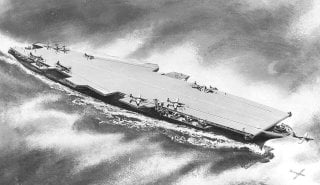In the aftermath of the Second World War, leaders of the United States Navy, such as Admiral Marc Mitscher, dreamed up a new aircraft carrier to fight what was then the budding Cold War against the Soviet Union.
By July 29, 1948, President Harry S. Truman had approved the creation of an entirely new set (five, to be precise) of aircraft carriers that were to be unlike anything that had come before. These five “supercarriers” as they were called were funded through the Naval Appropriations Act of 1949. The USS United States (CVA-58) was to be the first ship of this new supercarrier class.
But the United States and its proposed sister ships were truly unique. They were designed to carry a massive amount of airpower and armaments onboard what many today, if this boat had made it off the drawing board, would think was an alien mothership (its physical features, while similar to other carriers, were truly distinct). Among the planes onboard were heavy bombers that would have been able to conduct nuclear strikes as part of the Navy’s contribution to the growing nuclear triad (nuclear deterrence through the maintenance of land, sea, and air forces).
When fully loaded, the United States would have displaced approximately 83,200 tons. She was to be 1,000 feet long without an island superstructure (hence, the earlier claim that this ship might have looked more like an extraterrestrial ship as opposed to an American flat top).
The reason that the Navy wanted to do away with the iconic island superstructure was to maximize deck space for launching and recovering multiple aircraft. Four aircraft elevators and four catapults that were capable of handling aircraft up to 100,000 pounds were installed.
Nuclear Payload and Heavy Bombers
The United States and her proposed sister ships were to carry nuclear payloads onboard as well. Had the United States been built it would have been the most expensive warship built by the US Navy until that time.
Despite receiving support from President Truman, all was not going well for the Navy and its supercarrier program. For example, the newly formed United States Air Force was viscerally opposed to limited defense funds going to the Navy to develop what the Air Force brass believed was a redundant and unnecessary feature.
According to the Air Force at the time, its Convair B-36 Peacemaker and other land-based bombers were more than adequate for nuclear deterrence. The assumption was that sea-based nuclear deterrence was redundant and wasteful of US tax dollars (which could be better spent on the Air Force).
The Revolt of the Admirals
This wasn’t just some anecdote to put in the footnote’s sections of history books or a passing reference for entertainment value. The interservice rivalry over the fate of the USS United States would lead to one of the most dangerous points in the affairs of the Pentagon.
That event was known as the “Revolt of the Admirals.”
America’s naval leadership had dug in and were defending what they believed were irresponsible attacks on a preferred capital ship, the United States, from greedy Air Force leaders who just wanted more money for their precious planes.
But once the Truman administration’s Secretary of Defense Louis A. Johnson waded into the fight on the side of the Navy; the moment that Johnson opted to cancel the USS United States on August 23, 1949, a mere five days after the keep for the ship was laid, the revolt began in earnest. America’s admirals believed that the Pentagon’s civilian leadership, as represented by Johnson, was decisively favoring the Navy over the Air Force.
Ultimately, the cancellation of the United States was a disaster for the Navy. Navy Secretary John Sullivan resigned in protest.
Interestingly, the United States, although she was never built, not only impacted the future of the Navy’s leadership and doctrine. This never-built boat impacted all subsequent aircraft carrier designs. Many of the hard lessons learned from the project were folded into the creation of the Navy’s successful Forrestal-class aircraft carriers, which became the first real supercarriers with angled flight decks, and other innovations that have become standard in most modern carrier design.
Brandon J. Weichert, a Senior National Security Editor at The National Interest as well as a Senior Fellow at the Center for the National Interest, and a contributor at Popular Mechanics, consults regularly with various government institutions and private organizations on geopolitical issues. Weichert’s writings have appeared in multiple publications, including the Washington Times, National Review, The American Spectator, MSN, the Asia Times, and countless others. His books include Winning Space: How America Remains a Superpower, Biohacked: China’s Race to Control Life, and The Shadow War: Iran’s Quest for Supremacy. His newest book, A Disaster of Our Own Making: How the West Lost Ukraine is available for purchase wherever books are sold. He can be followed via Twitter @WeTheBrandon.
Image: Wikimedia Commons.

